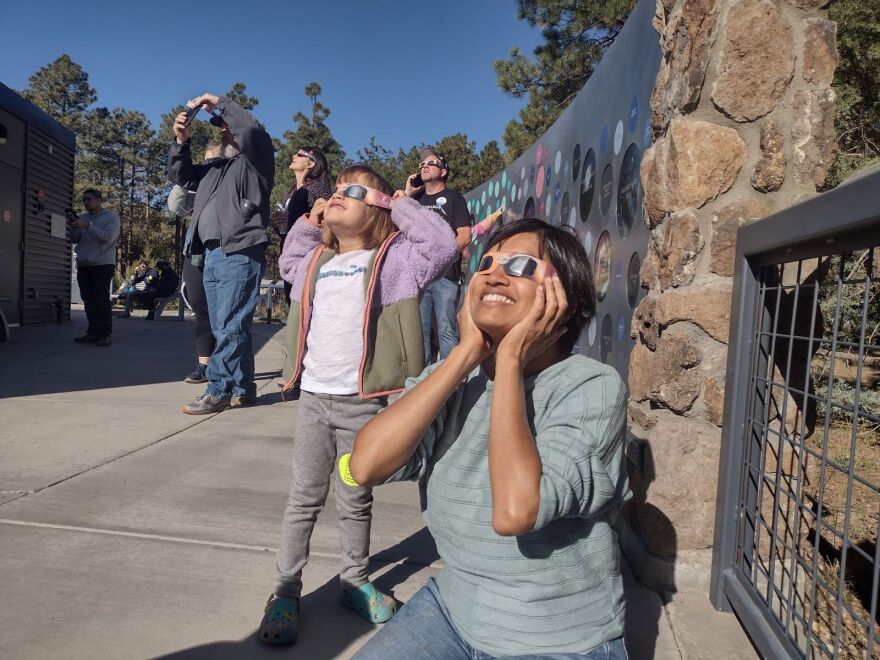On Monday a partial solar eclipse will be visible everywhere in the Lower 48 states of the United States. Anyone standing in a narrow band stretching from Texas to Maine will experience a total solar eclipse. KNAU’s Melissa Sevigny spoke with Northern Arizona University astronomer Cristina Thomas about why the experience is extraordinary.
First off, for folks who are here in northern Arizona and they’re not traveling to see this eclipse, what are they going to see?
This is going to play out over the course of about two and a half hours, so starting in the late morning they’re going to start to see the moon move in front of the sun. The way I like to think about it is that it kind of looks like someone has taken a bite out of the sun, so you see this little arc that’s dark that you wouldn’t expect. And of course you only see this by using safe eclipse glasses. We never encourage people to look at the sun, obviously…. I often suggest people go to the American Astronomical Society’s website where they have a list of vendors with safe glasses.
Okay. And we should say that eclipses are relatively rare events where the moon is moving in front of the sun.
It’s true, the moon is moving in front of the sun, and it’s really exciting. Some amount of eclipse will happen about twice a year somewhere on the planet, but it’s exciting to have it move over the United States in particular, so that so many people in this country can see some amount of eclipse happen.
And not everyone will choose to do that, I want to acknowledge that here in Arizona especially, Navajos, for them it’s traditionally a time of prayer, a time to stay indoors. But for those are who are traveling to go see eclipse, there’s a part of the country that will see a total solar eclipse. What is special about that? Why are so many people getting in their cars or getting on an airplane to go see it?
It’s interesting because the way you think about blocking out some sunlight, you might think that getting a large fraction of the sun eclipsed will really dim the sky. In many cases, it won’t. In northern Arizona we can expect something like 68 percent of the sun to be covered at the maximum point, but it’s not really going to impact how bright the day looks. If you get to the path of total eclipse, it’s going to look far more like dusk…. And we’ve lost so much sunlight by the moon covering the sun from our perspective that we can start to see things we can’t normally see. That includes what’s called the solar corona, which is the outer atmosphere of the sun. And it’s fantastic to see, it’s this interesting phenomenon that we don’t really think about when we’re looking at the sun and can only be seen under these conditions.
And some people travel all over the world to have these very brief experiences, a couple of minutes, where the moon has completely eclipsed the sun. I think it’s fascinating that this happens just because of coincidence, right? The moon happens to be the right size.
And that’s actually something that I find the most fascinating about this, because the moon happens to be the right size from our perspective, but right now the moon is actually moving further away from us. It’s not a very big effect, it’s about 1.5 inches per year. But that means in something like 600 million years we’re not going to have this total eclipse phenomenon anymore. I feel like we are living on this planet at exactly the right time. In geology terms, 600 million years is nothing. But from our lifetime, we get to see this really interesting thing, because we’re here at the right time to see it.
When is the next time in the United States that we’ll be able to see a total solar eclipse?
There is a total eclipse in the northern part of the continental U.S. in 2044, but the next total solar eclipse that goes across the country is actually the following year, so 2045 is when a lot of people will have an opportunity to see a total eclipse from this country.
So not quite a once in a lifetime experience, but it’s a few decades out before you’ll get another chance to do this without maybe having to get on an airplane.
It’s true, it’s going to be quite a ways.
Cristina, thank you so much for speaking with me.
Thank you, always a pleasure.
Partial eclipse in Arizona on Monday, April 8:
Begins: 10:12 a.m. MST
Maximum: 11:23 a.m. MST
Ends: 12:37 a.m. MST
More information:
Lowell Observatory’s 2024 Great American Eclipse Party: https://lowell.edu/experiences/american-eclipse-party/
Eye safety: https://eclipse.aas.org/eye-safety
Approved eclipse glasses vendors: https://eclipse.aas.org/eye-safety/viewers-filters




